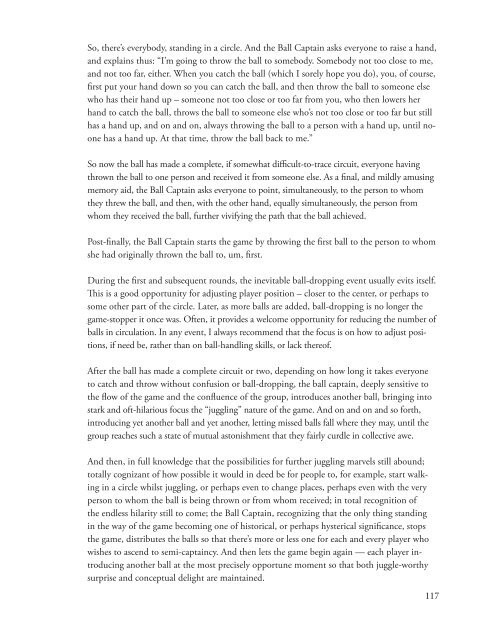A-Playful-Path_DeKoven-web
A-Playful-Path_DeKoven-web
A-Playful-Path_DeKoven-web
Create successful ePaper yourself
Turn your PDF publications into a flip-book with our unique Google optimized e-Paper software.
So, there’s everybody, standing in a circle. And the Ball Captain asks everyone to raise a hand,<br />
and explains thus: “I’m going to throw the ball to somebody. Somebody not too close to me,<br />
and not too far, either. When you catch the ball (which I sorely hope you do), you, of course,<br />
first put your hand down so you can catch the ball, and then throw the ball to someone else<br />
who has their hand up – someone not too close or too far from you, who then lowers her<br />
hand to catch the ball, throws the ball to someone else who’s not too close or too far but still<br />
has a hand up, and on and on, always throwing the ball to a person with a hand up, until noone<br />
has a hand up. At that time, throw the ball back to me.”<br />
So now the ball has made a complete, if somewhat difficult-to-trace circuit, everyone having<br />
thrown the ball to one person and received it from someone else. As a final, and mildly amusing<br />
memory aid, the Ball Captain asks everyone to point, simultaneously, to the person to whom<br />
they threw the ball, and then, with the other hand, equally simultaneously, the person from<br />
whom they received the ball, further vivifying the path that the ball achieved.<br />
Post-finally, the Ball Captain starts the game by throwing the first ball to the person to whom<br />
she had originally thrown the ball to, um, first.<br />
During the first and subsequent rounds, the inevitable ball-dropping event usually evits itself.<br />
This is a good opportunity for adjusting player position – closer to the center, or perhaps to<br />
some other part of the circle. Later, as more balls are added, ball-dropping is no longer the<br />
game-stopper it once was. Often, it provides a welcome opportunity for reducing the number of<br />
balls in circulation. In any event, I always recommend that the focus is on how to adjust positions,<br />
if need be, rather than on ball-handling skills, or lack thereof.<br />
After the ball has made a complete circuit or two, depending on how long it takes everyone<br />
to catch and throw without confusion or ball-dropping, the ball captain, deeply sensitive to<br />
the flow of the game and the confluence of the group, introduces another ball, bringing into<br />
stark and oft-hilarious focus the “juggling” nature of the game. And on and on and so forth,<br />
introducing yet another ball and yet another, letting missed balls fall where they may, until the<br />
group reaches such a state of mutual astonishment that they fairly curdle in collective awe.<br />
And then, in full knowledge that the possibilities for further juggling marvels still abound;<br />
totally cognizant of how possible it would in deed be for people to, for example, start walking<br />
in a circle whilst juggling, or perhaps even to change places, perhaps even with the very<br />
person to whom the ball is being thrown or from whom received; in total recognition of<br />
the endless hilarity still to come; the Ball Captain, recognizing that the only thing standing<br />
in the way of the game becoming one of historical, or perhaps hysterical significance, stops<br />
the game, distributes the balls so that there’s more or less one for each and every player who<br />
wishes to ascend to semi-captaincy. And then lets the game begin again — each player introducing<br />
another ball at the most precisely opportune moment so that both juggle-worthy<br />
surprise and conceptual delight are maintained.<br />
117


